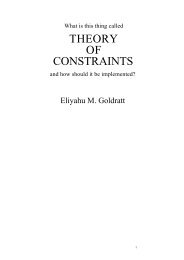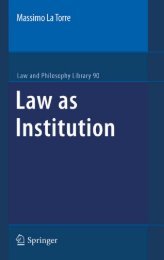Making of a German Constitution : a Slow Revolution
Making of a German Constitution : a Slow Revolution
Making of a German Constitution : a Slow Revolution
Create successful ePaper yourself
Turn your PDF publications into a flip-book with our unique Google optimized e-Paper software.
Prelude to Modern <strong>German</strong>y • 47preference for a mixed constitutional monarchy. 106 Closer to the age, Samuel Pufendorf(1632–1694) regarded Conring as more radical, theoretical and better informedabout politics than most in his generation. 107 The ideas <strong>of</strong> key political thinkers, includingBaruch Spinoza, Pufendorf, Gottlieb Samuel Treuer and Ulrich Huber, werein some way indebted to Conring’s work. 108 Certainly, through at least Pufendorf,Conring’s political thought was bequeathed to the nineteenth-century generation <strong>of</strong><strong>German</strong> legal scholars. Finally, the most important point <strong>of</strong> this section has been toidentify the critical political rupture that resulted from the appearance <strong>of</strong> Discursusnovus. There was no longer a legitimate legal basis for imperial absolutism in<strong>German</strong>-speaking Europe after Conring showed the myth <strong>of</strong> Roman imperium to belittle more than a ‘delusion’ in his words. Discursus novus proved to be the importantfinding that allowed for the development <strong>of</strong> the enlightened legal reforms that werealready underway, in the <strong>German</strong> lands, just prior to the French <strong>Revolution</strong>.Prelude to Modern <strong>Constitution</strong>al TransformationThe constitutional crisis <strong>of</strong> the 1760s formed the immediate prelude to modern <strong>German</strong>constitutional transformation, and it was in this context that the <strong>German</strong> identification<strong>of</strong> sovereignty with jurisdiction began to take on modern form. By themiddle <strong>of</strong> the eighteenth century, a collection <strong>of</strong> documents was recognized by contemporariesas compromising the constitutional basis <strong>of</strong> the Empire. The GoldenBull <strong>of</strong> 1356 was seen as the founding constitutional document. It confirmed andamplified the arrangements set forth in the Declaration <strong>of</strong> Rehnse <strong>of</strong> 1338, whichfirmly established the <strong>of</strong>fice <strong>of</strong> the emperor as an elective one and designated theelectors. The second major document was the Landfriede <strong>of</strong> 1495, which, as JohannJakob Moser wrote, had replaced Faustrecht (right <strong>of</strong> private warfare) and was ‘anagreement and law (Vertrag und Gesetz) between the emperor and the imperial Estatesthat nobody in the <strong>German</strong> Empire shall use force against the other, but ratherthe course <strong>of</strong> law’. 109 The year 1495 also witnessed the Reception <strong>of</strong> Roman Lawin the form <strong>of</strong> the corpus iuris civilis and the establishment <strong>of</strong> the imperial appellatejurisdiction <strong>of</strong> the Reichskammergericht mentioned earlier. In addition to thesemeasures, the Peace <strong>of</strong> Augsburg <strong>of</strong> 1555 allowed princes to select Lutheranism orCatholicism for their realms and reaffirmed their autonomy in the states. It was accompaniedby the Execution Ordinance, which also formed a part <strong>of</strong> the basic law<strong>of</strong> the Empire. Procedural ordinances, electoral capitulations and finally, the Peace<strong>of</strong> Westphalia <strong>of</strong> 1648, from which derived the Landeshoheit (state autonomy), wereseen as the final measures <strong>of</strong> imperial basic law. 110 It is important to keep in mindthat no one single document was understood to stand alone as a basic law. Ratherthe imperial constitutional outlook subscribed to the idea that the constitution hadcome into being through successive agreements over time and was comprised <strong>of</strong>many legal measures.




